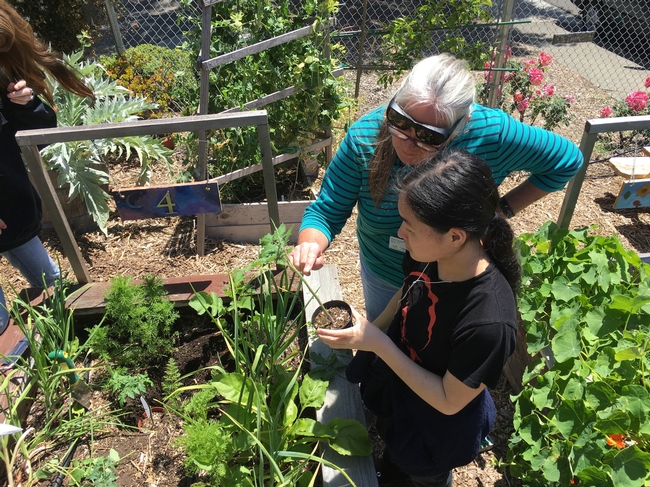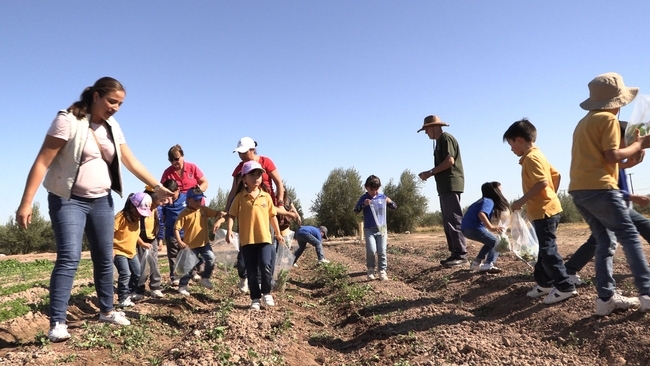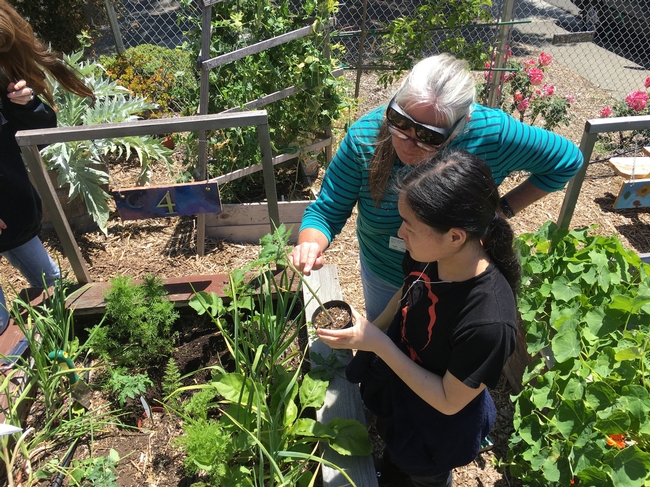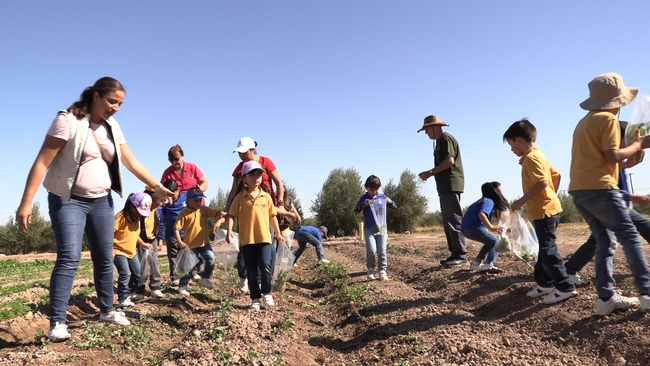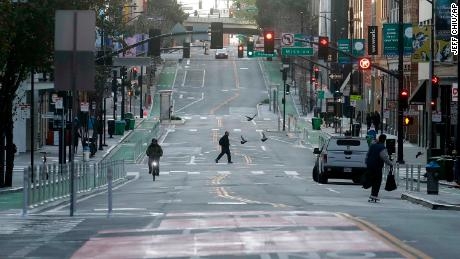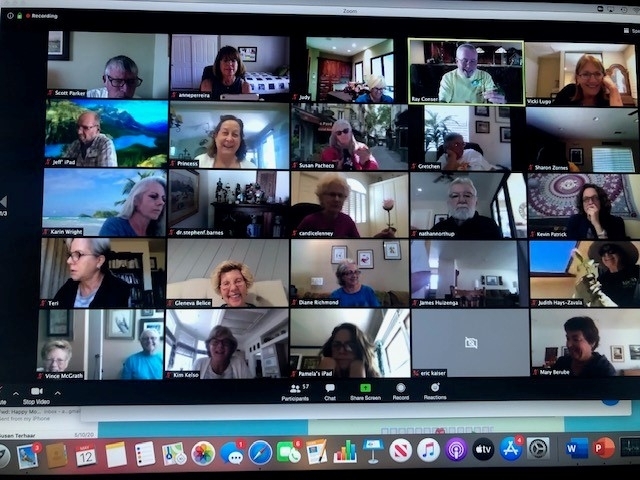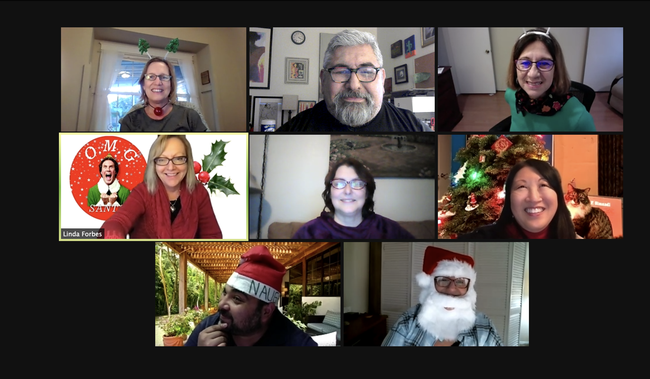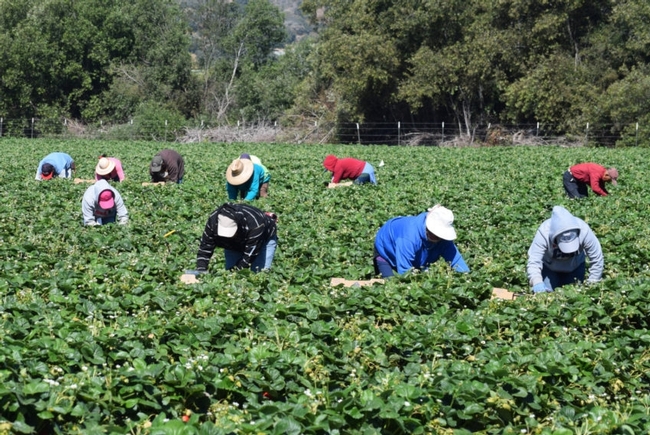- Author: Ricardo A. Vela
They are considered the backbone of any non-profit organization. They strongly believe in the objectives of the institution to which they invest their time. Of course, I am talking about volunteers. Special people whose motivation is to change the communities where they live. Their passion makes them the perfect ambassadors of the organizations and often times their work catches the eyes and the pockets of donors.
According to Gemma M. Miner, volunteer coordinator of Agriculture and Agricultural Resources at the University of California (UC ANR), this institution has more than twenty-six thousand volunteers, who perform a variety of activities within the programs 4-H Youth Development, UC Gardener Master, UC Master Food Preserver, and UC California Naturalist among others. These volunteers perform a variety of activities such as educating and mentoring participants and representing their program and UC ANR at public events.
UC ANR volunteers are estimated to accumulate about two million public contacts annually (data prior to COVID-19) in activities where they promote research-based information from UC ANR experts.
One of UC ANR's goals since 2018 is for academics to develop and manage systems that allow volunteers to lead projects, with the intention of strengthening volunteer engagement.
Miner emphasizes that the search for volunteers is continuous, however. Due to the diversity of UC ANR's state programs and the strategic locations of the Cooperative Extension offices, attracting the right people is not a difficult task.
But who are the right people to volunteer at UC ANR?
According to Miner, the ideal candidate is any adult willing to contribute to improve the lives of Californians. "Collaborating with UC ANR is a lot of fun and rewarding, as you have the opportunity to return to the community what it has given us and often help families who desperately need us to support them," she says.
Volunteering Challenges
As the population in California moves from rural to urban areas, low-income families face disadvantaged situations. As a result, 6.8 million people live below the poverty level. This represents 1 in 6 California residents.
Latinos are the ethnic group hit hardest by this problem.[1]In California, 40% of the population is of Latino origin, yet economic and social disparity is the sad reality for many of these families. Latinos comprise 51.4% of the population living below poverty level,[2] which is why UC ANR maintains its commitment to help these families through the available programs. In order to successfully achieve this objective, it is vital to have volunteers who are not only bilingual, but also bicultural.
Juan Jiménez and his wife Michele are two of thousands of volunteers who collaborate with UC ANR. Both participate with the 4-H youth development program in Riverside County and know the importance of being bilingual and bicultural. They also know first-hand the reward of volunteering. "Volunteering makes me feel human and that I'm contributing to the community and my family," says Juan.
For Michele, volunteering for the community she lives in is a natural thing: "Since I was a child, I have been a volunteer. My parents instilled in me the service to our community, our church. To me it is a very normal and satisfying thing."
Every year in April, non-for-profit organizations everywhere in the country celebrate and recognize the work of those tireless people who dedicate their free time for the benefit of others. UC ANR joins them and from the bottom of our hearts we say:
Thank you, Volunteers!!
----------------------------
[1] Public Policy Institute of California - June 2020
[2] US Census Bureau 2020
- Author: Ricardo A. Vela
Son considerados la columna vertebral de toda organización sin fines de lucro, y son aquellas personas que comparten los objetivos de la institución a la que dedican su tiempo. Tiene en común el sentimiento de que con sus acciones pueden cambiar comunidades o vidas y en la mayoría de las ocasiones se convierten en los mejores promotores de esas organizaciones ante el público en general y lo más importante ante los donantes.
Me refiero a los voluntarios, hombres, mujeres, jóvenes y adultos que, en busca de la recompensa más gratificante, ayudar al prójimo, se involucran en las organizaciones que promueven los valores en los que creen.
De acuerdo con Gemma M. Miner, coordinadora de voluntarios de la División de Agricultura y Recursos Agrícolas de la Universidad de California (UC ANR por sus siglas en inglés) esta institución cuenta con más de veintiséis mil voluntarios, quienes desempeñan una variedad de actividades dentro de los programas de 4-H, Maestro de Jardineros, Maestros Conservadores de Alimentos, y California Naturalistas entre otros. Los voluntarios realizan una gran variedad de actividades como educar, asesorar y fungir como representantes de su programa y de UC ANR en eventos públicos.
Se calcula que estos voluntarios acumulan cerca de dos millones de contactos públicos anualmente (datos antes de COVID-19) en actividades donde promueven la información basada en las investigaciones de los expertos de UC ANR.
Uno de los objetivos de UC ANR desde el 2018 es que los académicos desarrollen y administren sistemas que permitan que los voluntarios lideren proyectos, y que de esta manera se fortalezca el compromiso de los voluntarios.
Miner, asegura que la búsqueda de voluntarios es continua, sin embargo, debido a la diversidad de los programas estatales de UC ANR y las ubicaciones estratégicas de las Extensiones Cooperativas atraer a las personas indicadas no es una tarea difícil.
¿Pero quiénes son las personas indicadas para ser voluntarios en UC ANR?
De acuerdo con Miner, el candidato ideal es cualquier persona dispuesta a contribuir con su granito de arena para mejorar las vidas de los californianos. “Colaborar con UC ANR es muy divertido y gratificante, ya que se tiene la oportunidad de regresar a la comunidad lo que esta nos ha dado y en muchas ocasiones ayudar a las familias que necesitan desesperadamente que las apoyen,” declara Gemma M. Miner.
Los Retos del Voluntariado
Conforme la población en california se desplaza de las zonas rurales a la mancha urbana, familias de escasos recursos y en situaciones de desventaja requieren más apoyo para salir adelante. Desafortunadamente como resultado de ello 6.8 millones de personas viven por debajo del nivel de pobreza, es decir 1 de cada 6 residentes en California[1]. Los latinos son el grupo étnico mas golpeado por este problema.
En California el 40% de la población es de origen latino, sin embargo, la disparidad económica y social es el pan de cada día para muchas de estas familias ya que los latinos son el 51.4% de la población que vive bajo el nivel de pobreza. [2]Razón por la cual UC ANR mantiene como uno de sus objetivos ayudar a estas familias a través de los programas disponibles y para ello es vital contar con voluntarios que sean no solo bilingües, sino también biculturales.
Juan Jiménez y su esposa Michele son dos de los miles de voluntarios que colaboran con UC ANR, ambos participan con el programa de desarrollo juvenil 4-H en el condado de Riverside y conocen la importancia de ser bilingües y la recompensa de ser voluntarios. “Ser voluntario me hace sentir humano y que estoy contribuyendo con la comunidad y con mi familia,” asegura Juan.
Mientras que, para Michele, servir a la comunidad en la que vive es algo natural. “Desde pequeña he sido voluntaria, mis padres me inculcaron el servicio a nuestra comunidad, a nuestra iglesia, para mi es algo muy normal y satisfactorio.”
En abril se celebra y reconoce la labor de los voluntarios, esas personas incansables que dedican su tiempo libre para el beneficio de otros.
Ante la gran labor que hacen en UC ANR les decimos humildemente a todos ellos
¡Muchas gracias!
[1] Public Policy Institute of California – June 2020
[2] US Census Bureau 2020
- Author: Ricardo Vela
As I reflect on how the pandemic has impacted us and how our ways of conducting ourselves and our business have changed, I realize that we all have a story to tell; some will be sad, others will be triumphant, and others full of hope. This is my story/our story (since I include my staff).
On a personal level, I can share that while several family members were seriously sick with COVID-19, fortunately, I did not lose any of them. The loss of many dear friends and their family members due to the virus left me wondering about my own vulnerability and mortality.
My staff also saw first-hand the pandemic's devastating effects. One of them lost her father to COVID-19 after a prolonged agony. Another lived in anguish due to her younger son's sickness, who is an essential worker. At times, we fell into depression, and anxiety took the best of us. “Who is next?" we wondered as we saw how personal the pandemic could get. It stopped being another headline and became real and painful.
As a team, during the pandemic, we have grown closer together. Even when we have not been in the same place for over a year, we pushed each other to think outside the box to accomplish our work and goals. We did better than ever before.
We missed the touch of our loved ones; some missed the laughter of their grandchildren. We missed the lack of social interaction, and the abrupt stop of our "normal" certainly took a toll.
We share tears of despair, impotence, and at times of joy! As a team, we pulled it together, we stopped being co-workers, and we became a family.
A year later, I can say we are stronger, more resilient. We learned that distance is only a click away, that we can express love in many ways. We are ready to face the "new normal."
COVID-19 – one year later testimonials
It started the first week of March as a casual conversation among myself and my staff about how the pandemic changed our lives, beginning on March 19, 2020, with the stay-at-home mandate.
Little did we know that we would be working from home one year later and not knowing when to resume our lives back to our old normality.
Immediately, we knew we needed to do something to capture the effects of our isolation, the challenges, the fear, the uncertainty brought by the pandemic directly to our houses. It also carried blessings and sorrows, anxiety and strength. It pushed us to do more and do better with fewer resources. It was a year of learning how to express our feelings and love in ways that we would have never imagined.
We needed to hear our peers' experiences, growth and adjusting to more challenges. We sent an email inviting all of UC ANR staff, academics, and leadership to participate. Right away, we started to get responses, some of them praising the idea or regretting not participating. Eighteen people accepted the invitation and shared with us intimate moments. Some found love in the middle of the storm. Others found time to reflect on the essential things in their lives. Others were just grateful for having a job, a roof over their heads. For some others, the pandemic opened a dark door they had closed and confronted them with their demons. Look for the emotional video on the UC ANR website and our social platforms on March 19, 2021.
COVID-19 and Mental Health
One year later, COVID-19 has left many scars: 500,000 deaths, unemployment, businesses trying to recover, a racially divided country, and mental health at the forefront. According to a report from the American Farm Bureau, two in three farmers/farmworkers say the pandemic has impacted their mental health. During the pandemic, they were more likely than other rural adults to have experienced anxiety, nervousness, or being on edge.
Twenty percent of the students interviewed during the survey done by activeminds.org said their mental health has worsened during the pandemic, while 38 percent have problems focusing on studies or work due to COVID-19.
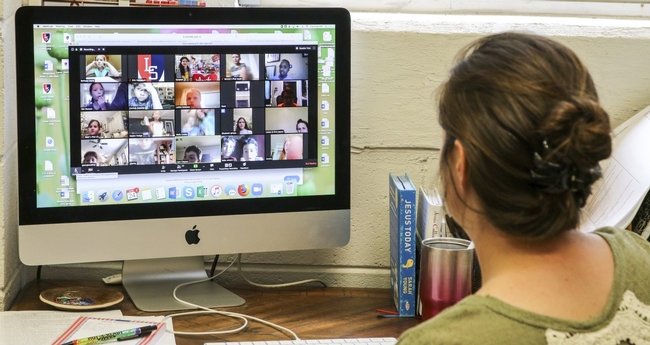
Young adults have been especially hard hit. According to the Kaiser Family Foundation (KKF) tracking poll, those aged 18-24 are about twice as likely as all adults to report new or increased substance use or recent suicidal thoughts.
More women than men are facing mental health challenges. The KKF tracking poll states that women have been more likely to report anxiety and or depressive disorder symptoms.
Experts recommend taking breaks from watching, reading, or listening to news stories, including those on social media. It's good to be informed, but hearing about the pandemic quite often can be upsetting. Consider limiting news viewing to just a couple of times a day and frequently disconnecting from phones, TVs, and computer screens.
- Author: Ricardo Vela
Al reflexionar sobre cómo COVID-19 impactó nuestras vidas, cambiando nuestras rutinas, obligándonos a permanecer aislados en casa, limitando nuestras acciones e interacciones sociales me di cuenta de que todos tenemos una historia que contar; algunas serán tristes, otras de triunfo y otras más de esperanza. A continuación, mi historia o más bien nuestra historia ya que he incluido a mis compañeros de trabajo bajo mi supervisión.
A nivel personal, puedo compartir que, aunque el virus del COVID-19 llegó desde muy temprano a contagiar a varios miembros de mi familia inmediata, afortunadamente ninguno enfermó gravemente y no tuvimos ninguna muerte que lamentar. Sin embargo, la pérdida de muchos amigos queridos y sus familiares debido a COVID-19 me golpeo fuerte, me sacudió dejándome con muchos cuestionamientos sobre mi propia vulnerabilidad y mortalidad.
Conforme pasó el tiempo, la falta de interacción social, la carencia de espacios protegidos y el temor ante lo desconocido hicieron mella en mi estado de ánimo. Fueron días y noches navegando sin rumbo fijo sobre un mar turbulento, que lo mismo pasaba de un suave vaivén en su oleaje, a una amenazante sinfonía sin coordinación, cuyo intimidante oleaje producía ansiedad.
Mis compañeros de trabajo vieron también de primera mano los efectos devastadores de la pandemia. Una de ellos después de una dura agonía perdió a su padre ante el COVID-19, otra más, vivió momentos de angustia debido al contagio de COVID-19 de su hijo menor, quien es un trabajador esencial.
Como equipo de trabajo, la pandemia nos ha permitido abrirnos más el uno al otro, tirar barreras acercándonos más, irónicamente, no hemos compartido el mismo lugar en más de un año. Descubrimos el poder de la sonrisa, de motivarnos mutuamente y empujarnos más allá de nuestra zona de confort, siempre pensando en métodos alternativos para lograr los objetivos de nuestro trabajo. Y puedo decirles que no solamente lo logramos sino que lo hicimos mejor que nunca.
A pesar de nuestro éxito laboral, a veces, caímos en la depresión. La ansiedad se llevó en momentos lo mejor de nosotros. Durante días cuando nuestra compañera Leticia perdió a su padre, por la pandemia, todos caímos en la desesperación, "¿quién es el siguiente?" Nos preguntábamos. El virus parecía estar más cerca y nosotros nos sentíamos impotentes ante esta amenaza, y así, nos percatamos que dejó de ser otro titular en las noticias y se volvió real y doloroso.
Nos perdimos el roce de la piel de nuestros seres queridos, el abrazarlos, el besarlos algunos extrañaban las risas de sus nietos. Echamos de menos la falta de interacción social, y la abrupta parada de nuestra "normalidad" ciertamente tuvo un costo.
¡Compartimos lágrimas de desesperación, impotencia y en momentos de alegría! Como equipo, lo logramos juntos, dejamos de ser compañeros de trabajo y nos convertimos en una familia.
Un año después, puedo decir que somos más fuertes, resistentes. En este año aprendimos que la distancia deja de exisitir con sólo un click, supimos como valorar los detalles de la cotidaniedad, aprendimos que podemos expresar nuestro amor de muchas maneras. Creo que un año despues, estamos listos para enfrentar la "nueva normalidad."
El Proyecto de testimonios COVID-19 – Un año después
Comenzó la primera semana de marzo como una conversación casual entre mi personal y yo sobre cómo COVID-19 cambió nuestras vidas, que comenzó el 19 de marzo de 2020, con el mandato de quedarse en casa.
Poco sabíamos que estaríamos trabajando desde casa un año después y sin saber cuándo reanudar nuestras vidas de vuelta a nuestra vieja normalidad.
Inmediatamente, sabíamos que teníamos que hacer algo para capturar los efectos de nuestro aislamiento, los desafíos, el miedo, la incertidumbre generada por la pandemia directamente a nuestras casas. También trajo bendiciones y penas, ansiedad y fuerza.
Tiempo que invito a la innovación para hacer más y hacerlo mejor con menos recursos. Fue un año de aprender a expresar nuestros sentimientos y amor de manera que nunca hubiéramos imaginado. Necesitábamos escuchar las experiencias vividas, el crecimiento y el ajuste de nuestros compañeros a más desafíos.
Enviamos un correo electrónico invitando a todo el personal de UC ANR, académicos, liderazgo a participar. De inmediato, empezamos a obtener respuestas, algunas de ellas alabando la idea, el concepto, lamentando no participar. Dieciocho personas aceptaron la invitación y compartieron con nosotros momentos íntimos.
Algunos encontraron el amor en medio de la tormenta. Otros encontraron una oportunidad para reflexionar sobre las cosas importantes en sus vidas.
Otros más estaban agradecidos por tener un trabajo, un techo sobre sus cabezas. Mientras que, para algunos otros, la pandemia abrió una puerta oscura que habían cerrado a y que los confrontó con sus demonios. Busque el emotivo video en el sitio web de UC ANR y nuestras plataformas sociales el 19 de marzo de 2021.
Un año después, COVID-19 ha dejado muchas cicatrices, 500.000 muertes en todo el país?, desempleo, empresas tratando de recuperarse, un país dividido racialmente, y ha traído a la luz pública el problema de la salud mental.
Según un informe de la American Farm Bureau,dos de cada tres agricultores/trabajadores agrícolas dicen que la pandemia ha impactado su salud mental. Durante la pandemia, los trabajadores del campo dijeron estar más propensos que los adultos rurales a experimentar ansiedad, nerviosismo y enfermedades mentales.

Un estudio realizado por el Centro para el Control de Enfermedades (CDC) reveló que el dolor, el aislamiento, la pérdida de ingresos y el miedo desencadenan condiciones de salud mental o exacerban las existentes durante la pandemia. También afirma que muchas personas pueden estar enfrentando mayores niveles de consumo de alcohol y drogas, insomnio, y la ansiedad debido a COVID-19.
Los adultos jóvenes han sido especialmente afectados. Según una encuesta de la Kaiser Family Foundation (KKF), las personas de 18 a 24 años tienen aproximadamente el doble de probabilidades que todos los adultos de reportar un nuevo o mayor consumo de sustancias o pensamientos suicidas recientes.
Más mujeres que hombres se enfrentan a desafíos de salud mental. La encuesta de seguimiento de la KKF afirma que las mujeres han sido más propensas a reportar síntomas de ansiedad o trastorno depresivo.
Los expertos recomiendan tomarse descansos para ver, leer o escuchar noticias, incluidas las de las redes sociales. Es bueno estar informado, pero escuchar acerca de la pandemia con bastante frecuencia puede ser molesto. Considere limitar las noticias a solo un par de veces al día y desconectarse de las pantallas del teléfono, la televisión y las computadoras por un tiempo.
- Author: Ricardo Vela
Agricultural workers have not stopped working since they were deemed essential at the start of the pandemic. They have continued to plant, harvest, and process the nation's food during the crisis as well as during devastating fires.
"They should give us wage support in agriculture. We expose ourselves every day to this virus, and we're not lucky enough to be able to work from home. It can't be harvested from a computer, said Martin, a 49-year-old farmworker from Southern California.
The lack of an adequate response from employers and the federal government has made agricultural workers feel used and abused, and doubly struck by the crisis. They claim that the government's lack of response has left them vulnerable to various health problems: Eliseo, a 40-year-old agricultural worker from the San Joaquin Valley, commented, "We're supposed to be indispensable and essential, but we don't seem to be essential -- like we're useless garbage you can throw away, and then they're going to hire more people. That's how I feel."
California's eight hundred thousand agricultural workers have been struck hard by COVID-19. Clara, a 53-year-old farmworker from the San Joaquin Valley, explained, "Things have changed drastically because we had to stop working. Because there hadn't been a good job as there would have been. Sometimes they wouldn't let us come to work because they didn't want a lot of people."
The phase two of the COVID-19 Pandemic report , (COFS) conducted by Bonnie Bade, PhD; Sarah Ramirez, PhD, MPH; Dvera I. Saxton, PhD. Made public on February 2nd, 2021, shows how the pandemic has worsened the economic vulnerabilities and fragility within the food system and increased disparities in insecurity, risk, and health for agricultural workers and their families. Clara's family is one of the affected
"We were out of work for almost two months. God only knows how we survived it because we don't even understand. We survived with the help of God and friends who gave us food,” she said.
The report states that agricultural workers need to continue working because of food and job insecurity, even while they are sick. Those who are unable to work cannot afford to take many days off for fear of not having enough money to pay rent and bring food to their families.
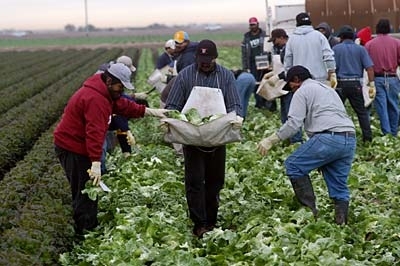
The conditions under which they carry out their work and transportation are two of the high-risk factors for agricultural workers to contract COVID-19. They often travel to the fields in large, overcrowded groups in a truck. And at work, all of them take their rest under a tent, without following health measures such as social distancing or mouth coverings. Pedro, a 45-year-old farmworker from the desert region, explained, "The concern is that we are full in transport. At lunch, they set up a 4x8 tent [to provide shade]. The foreman yells at us that the work must continue and that he doesn't care if one has COVID-19 or not. They don't even wear masks. The chief kept quiet and didn't tell anyone until some of them died."
During surveys conducted in the investigation of field workers' conditions, the farmworkers denounced the inconsistent implementation of public health policy in agricultural workplaces. The report adds that the government did not recognize their concerns about workplace safety or, in some cases, they were openly dismissed and mocked by employers, supervisors, and government agencies responsible for protecting workers' health.
Eliseo, an agricultural worker from the San Joaquin Valley, testified, "We reported that they [bosses] didn't give us face masks. In other words, we asked them for face masks, and they just laughed. And we ordered soap to wash our hands because there were so many places where we couldn't wash our hands, and they just laughed. And several of my co-workers and I called Cal/OSHA, and we got together to call for help before we could get infected. And they [Cal/OSHA] told us they were going to send letters and they were going to talk to our boss, but they never did anything."
The mental health of agricultural workers and their families during the pandemic is another major concern shown in the report. Their main anxieties are the fear of getting sick or infecting others, losing income and jobs, and being evicted from their homes. Marcos, a 45-year-old farmworker from the San Joaquin Valley, explained, "If we don't work, we don't pay bills, we don't buy food, we don't pay the rent, and then where are we going to live?"
Eduardo, a 31-year-old agricultural worker also from the San Joaquin Valley, said, "I'm afraid to get sick, but what keeps me awake at night is the idea that I'm infectious but symptomless, and it makes me think maybe it's my fault they closed our workplace because I infected all my friends. That's a big fear that invades my thoughts."
The lack of social support networks, including extended family, churches, and other community spaces that have been limited for farmworkers, has harmed these communities as it has done for the rest of the population.
On testing and vaccination, the report notes that the spread of misinformation due to conspiracy theories and the lack of vision of government agencies to offer agricultural workers evidence at nearby sites has created a high mistrust among these families. For indigenous language speakers, not understanding where to test, how to test, and interpreting and acting on the results was even more frustrating. Lupe, a 30-year-old Oaxacan farmworker from Southern California, said, "We don't know, or we don't go. We haven't been to do the coronavirus test because we don't know where to go. If they give it to us, we'll go because we don't know where to go."
As for vaccines, the study shows that side effects are a great fear. Simultaneously, a smaller percentage of males reported not being interested in getting vaccinated for fear of being microchip implanted, while women were reluctant to get vaccinated for fear of becoming infertile. 12% showed a distrust of the government.
The coalition of community organizations and universities recommends creating a culture of equity for field workers.
- As essential workers in national and global food systems, policies should include food and agricultural workers in all financial assistance and aid programs at the federal, state, county, and municipal levels, regardless of their immigration status.
- During school closures, there must be ongoing financial assistance for families with at least one adult staying at home or forced to stay home due to reduced hours, illnesses, temporary closures, staff reductions, or layoffs.
- Creation of culturally and linguistically appropriate places of communication for agricultural workers, such as regionally organized telephone lines, attended by persons in that community, during hours favorable to these workers, to report on violations of the COVID-19 protocol and other breaches of the protocol related to work in times of pandemic.
- In pandemic and ordinary circumstances, public health and occupational health and safety messages should remain clear and consistent in this regard. Messaging must be relevant for language and culture, but it must also come from trusted sources in the community.
- Expansion of testing and vaccination efforts in rural communities. Agricultural workers will benefit from appointment sites for free trials in places near their homes or workplaces.
- Agricultural workers should be included and represented in the design and dissemination of each and every public health campaign aimed at them. Agricultural workplaces should appoint field workers to serve as health and safety ambassadors, offering them a higher salary.

